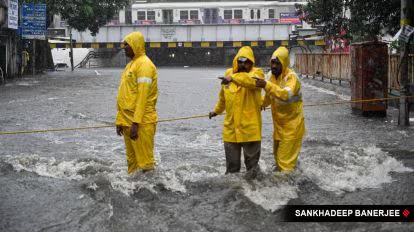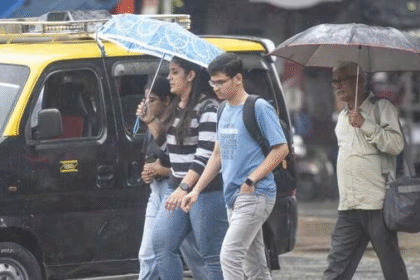When Urban Wealth Fails the Poor: How City Planning Neglect Fuels Flood Disasters
On May 30, Guwahati was brought to a standstill as a brief but intense downpour followed by persistent rainfall throughout the day led to severe flooding across the city and soon escalated into one of its worst urban artificial flash flood incidents in recent times.
Several low-lying and high-traffic areas abutting G.S. Road, including Ganeshguri, Tarun Nagar, Jyotikuchi, Jatia, Ghoramara and the area near Downtown Hospital were completely inundated.
Similarly, areas adjoining R.G. Baruah Road, particularly the flood-prone localities of Anil Nagar and Nabin Nagar, were submerged under waist-deep water, making vehicular movement impossible and causing widespread commuter hardship.
The crisis extended to Guwahati’s national highway network. Sections of National Highway (NH) 27, a major arterial road running from Jalukbari to Khanapara, witnessed severe waterlogging, especially near the Boragaon flyover, an area already under public scrutiny for drainage failures. Designed to improve traffic flow, the newly constructed flyovers along NH-27 instead became choke points, drawing criticism over poor planning and execution.
Adding to the chaos, NH-6 near Jorabat, which connects Guwahati to Meghalaya and the Barak valley, experienced severe flooding. Torrential rain and runoff from the Meghalaya hills turned the highway into a flowing river, submerging roads and halting movement between Guwahati and Shillong. The disruption on NH-6 affected not only cross-state traffic but also freight and emergency services.
Meanwhile, NH-37, the lifeline connecting Upper Assam to Guwahati, remained in a state of neglect with potholes, damaged culverts and surface erosion making travel perilous.
The flooding exposed the vulnerability of the city’s major transport corridors and raised serious concerns about infrastructure resilience.
Public transport collapsed citywide, forcing many to abandon vehicles to manage on their own. Ride-hailing services such as Uber, Ola and Rapido refused to go. Ferry services between Guwahati and North Guwahati were suspended, leaving riverine communities disconnected. The lack of visible response from Kamrup Metropolitan district officials and the Guwahati Municipal Corporation only deepened public frustration and helplessness.

Vehicles move through a waterlogged road after heavy rainfall in Guwahati on May 30, 2025. Photo: PTI.
In Rukminigaon, one of the worst-affected neighbourhoods, floodwaters rose to waist-level once again. When MP Bijuli Kalita Medhi visited the area on May 31 to review the situation, residents openly expressed their anger, citing years of ignored pleas regarding chronic waterlogging.
Rubber boats from the State Disaster Response Force had to be deployed to ferry people across their own streets, a sight now all too familiar in the locality. Over time, Rukminigaon has become symbolic of the city’s broader failure to address recurring urban flooding.
Padma Shri awardee, social activist and former MLA Ajoy Kumar Dutta has strongly criticised the authorities, stating that effective flood management in Guwahati is impossible without first addressing the city’s poor drainage system.
He challenged the administration, alleging that the drains have not been cleaned for the past decade despite crores of rupees being spent under the Smart City project. He emphasised that without a proper underground sewerage system, Guwahati cannot truly be called a smart city.
The India Meteorological Department issued a red alert for May 31 and an orange alert for June 1, indicating continued risk of heavy rainfall. Nearly half the city experienced some form of flooding within 24 hours, severely disrupting daily life, commercial activity and essential services.
This devastating episode has once again brought to light the urgent need for sustainable urban planning, improved drainage infrastructure and accountable governance in Guwahati. This event was not merely a natural disaster but exposed the failure of urban planning and infrastructure development in a city once celebrated as a burgeoning urban centre.
The floods revealed a systemic problem where development decisions are driven more by the interests of the wealthy and powerful than by the needs of the general population.
Guwahati’s urban growth has long been uneven, shaped by unequal migration patterns, the expansion of unregulated slums and the neglect of peripheral areas. Many migrants escaping rural poverty and climate crises have settled in informal settlements located in ecologically sensitive zones, hillsides, floodplains and wetlands, areas especially vulnerable to flooding.

National Disaster Response Force personnel and others move through a waterlogged road aboard a rescue boat to distribute relief material to affected people in Guwahati on May 31, 2025. Photo: PTI.
At the root of the disaster lies a profound ecological neglect: unchecked concretisation, rampant hill-cutting and the encroachment of wetlands have choked natural drainage channels. Commercial interests, backed by influential lobbies, have replaced water-absorbing green spaces with malls, luxury housing and office towers.
These developments primarily serve an affluent minority, while the majority of the city’s residents face the devastating consequences of environmental degradation. Guwahati’s natural landscape, a valley marked by rivers and hills, has been reshaped with little regard for ecological balance or long-term resilience.
Chief minister Himanta Biswa Sarma has sparked controversy by blaming hill-cutting activities in neighbouring Meghalaya for exacerbating Guwahati’s flood crisis. He accused Meghalaya of engaging in unchecked earth-cutting in the hills, warning that if such practices continue, Guwahati could “turn into an ocean”.
The Assam government escalated the issue to the Supreme Court’s Central Empowered Committee, demanding an investigation into Meghalaya’s actions.
Meghalaya’s disaster management minister Kyrmen Shylla promptly rejected these claims, arguing that Assam must take responsibility for its own urban infrastructure failures. He stressed that the recurring flooding was primarily due to poor drainage and inadequate urban planning within Guwahati itself, urging Assam to focus on improving its internal systems instead of blaming neighboring states.
He even added, “even if water flows from our state, that’s a natural occurrence, Meghalaya receives the highest rainfall in the region.”
This quickness to blame the other side instead of a nuanced understanding reinforces the fragmented and reactive nature of urban environmental governance in the region, where political rivalry hampers the collaborative, science-based planning needed to address climate risks effectively.
Despite India’s constitutional promise of universal adult suffrage, the reality in the event of the flash floods in Guwahati reveals a stark inequality in political influence. Wealthy elites continue to shape urban development priorities, allocating resources toward upscale neighbourhoods, commercial complexes and luxury housing, while neglecting essential infrastructure like drainage and flood prevention in poorer areas.

A man walks past a road partially washed away after heavy rainfall in Guwahati on May 31, 2025. Photo: PTI.
This unequal development model leaves working-class communities disproportionately exposed to disasters. The floods in Guwahati are not isolated incidents but symptoms of a broader system where political power and economic capital converge to protect elite interests at the expense of the majority.
Economist Thomas Piketty has highlighted that concentrated wealth has historically led to concentrated political power. From property-based voting rights to today’s dominance of lobbying, campaign financing and media control by the wealthy, elites have consistently shaped policies to preserve their advantages.
Guwahati’s infrastructural failures reflect this dynamic, where urban development serves business and affluent lifestyles, while ordinary citizens bear the cost of neglect and inadequate governance.
Political theorists like Benedict Anderson remind us that a state is more than a bureaucracy; it is an “imagined community” sustained by shared trust and collective responsibility. When the state’s priorities are captured by capital, this trust dissolves, deepening inequality and eroding democratic values.
Yet, within this crisis lies a possibility – of reclaiming the democratic ideal from the grip of economic elitism.
In three of Piketty’s books concerning the history of inequality, Top Incomes over the Twentieth Century (2001), Capital in the 21st Century (2013) and Capital and Ideology (2019), he has argued that history has shown us that public action can challenge entrenched power. If today’s critique of corporate-captured democracy is to be meaningful, it must be accompanied by institutional proposals that redistribute both voice and value.
What Guwahati and cities across India urgently need is a framework for participatory urban governance: transparent planning, ecological accountability and the fair taxation of billionaires and multinational giants. Only through such systemic shifts can tax revenue be redirected toward resilient infrastructure, inclusive development and everyday dignity for all.
In reimagining Guwahati’s future, we must not settle for technocratic fixes or blame games. We must ask: who shapes the city, who pays the price and who decides? A city where floods spare the elite and submerge the working poor is not an act of nature, it is a failure of justice.
It is time to build cities where constitutional promises are not aspirational texts, but lived realities, where the right to live with safety, equity and dignity flows stronger than rain and where constitutional promises become lived realities for everyone.
Also Read: Top 8 Benefits of Combining Drone Surveillance and Aroma Farming in Jammu & Kashmir








